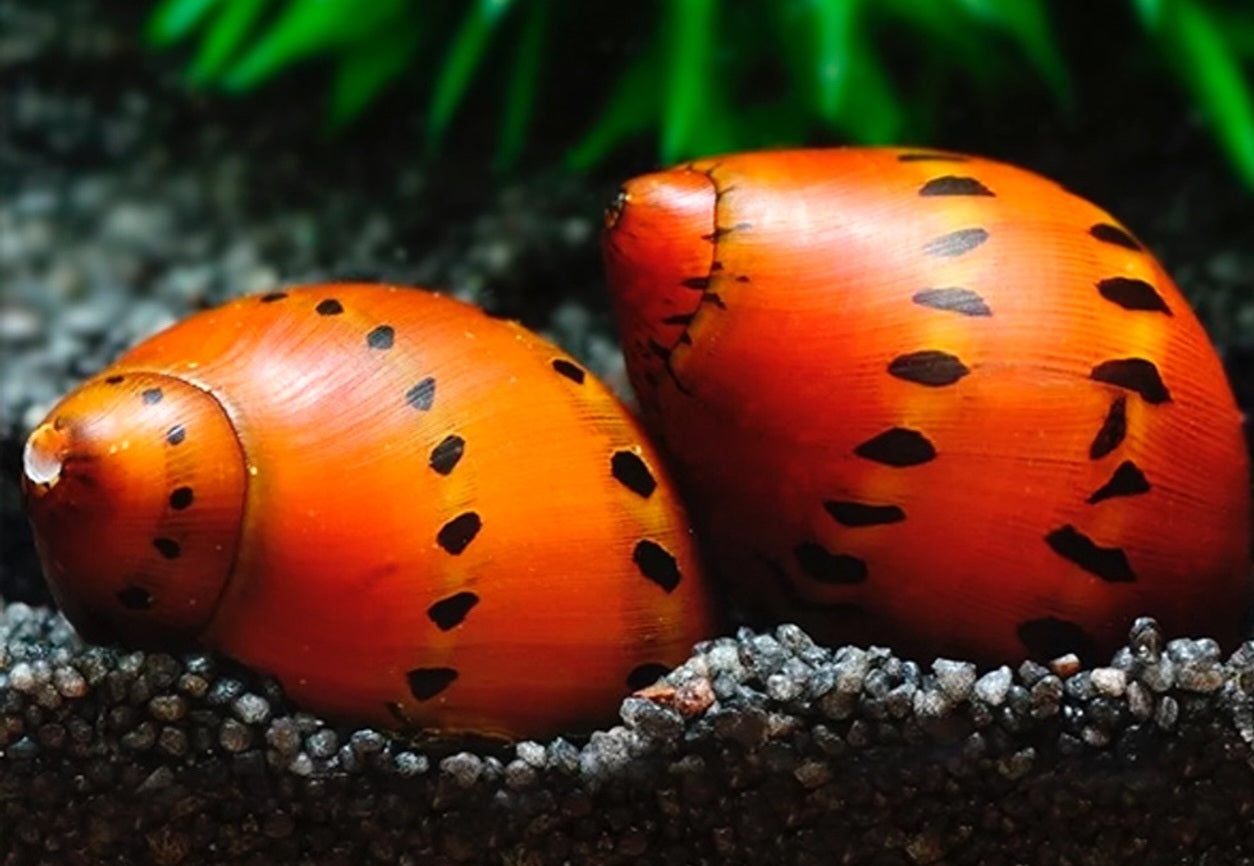Red Spotted Nerite Snail
Red Spotted Nerite Snail
Low stock: 10 left
Couldn't load pickup availability
The Red Spot Nerite Snail (Neritina natalensis) is a strikingly beautiful freshwater snail, known for its small size, hardiness, and distinctive appearance. It is particularly popular among aquarium hobbyists because of its algae-eating habits, colorful shell markings, and peaceful nature.
Here are some key facts about the Red Spot Nerite Snail:
1. Appearance:
-
Shell Color: The Red Spot Nerite Snail has a unique, smooth, and glossy shell with a dark, almost black background and bright red spots scattered across the surface. The spots can vary in size and number from snail to snail, making each one look slightly different.
-
Size: These snails are relatively small and grow to about 1 inch (2.5 cm) in diameter, which makes them ideal for smaller tanks and aquariums.
-
Body Color: The soft body of the snail is typically a pale beige or light brown, contrasting with the dark shell.
2. Habitat:
-
The Red Spot Nerite Snail is a freshwater species but is also found in brackish water in its natural habitat. However, it is commonly kept in freshwater aquariums with stable water parameters.
-
They prefer a water temperature of 72°F to 78°F (22°C to 26°C) and neutral to slightly alkaline water (pH 7.0–8.0).
-
While they do well in aquariums, they may sometimes venture outside of the water if there are gaps, so it’s important to have a secure tank lid.
3. Diet:
-
Algae-Eaters: Red Spot Nerite Snails are known for their ability to consume algae, including green, brown, and blue-green algae, which makes them excellent tank cleaners.
-
They will often be seen grazing on aquarium glass, decorations, and plants.
-
While algae makes up the majority of their diet, you can supplement their nutrition with blanched vegetables (like zucchini or spinach) or algae wafers if the tank doesn’t have enough natural algae.
4. Reproduction:
-
Reproduction in Freshwater: One of the unique aspects of the Nerite Snail is that they will not reproduce in freshwater aquariums because their eggs require brackish conditions to hatch. They lay small, white eggs that are usually visible on tank surfaces, but they will not hatch unless the water conditions are brackish.
-
This makes them a great option for hobbyists who don’t want to deal with snail overpopulation in their freshwater tanks.
5. Behavior:
-
The Red Spot Nerite Snail is a peaceful and non-aggressive species. It gets along well with most tank mates, including other snails, fish, and invertebrates.
-
They are active grazers, often moving around the tank looking for algae to eat, but they are not known to harm plants.
6. Care Tips:
-
Water Quality: They are sensitive to poor water quality, so it's important to maintain clean, well-filtered water and perform regular water changes.
-
Calcium: Like other snails, they need access to calcium in the water to maintain their shells. You can provide calcium through calcium-rich supplements or by adding crushed coral or cuttlebone to the tank.
-
Tank Lid: Since Nerite Snails may occasionally climb out of the water, a secure tank lid is recommended to prevent them from escaping.
7. Tankmates:
-
Red Spot Nerite Snails are peaceful and can live with a variety of tank mates, including tetras, guppies, bettas, and peaceful bottom dwellers.
-
Avoid keeping them with large, aggressive fish or species that may try to eat them, as they are small and vulnerable.
8. Benefits:
-
Algae Control: One of the main reasons people keep Nerite Snails is for their algae-eating capabilities. They help keep the tank clean by consuming various types of algae, particularly green and brown algae.
-
Low Maintenance: They are easy to care for and are not as prone to disease as some other snail species.
The Red Spot Nerite Snail is a beautiful and beneficial addition to any freshwater aquarium. Its colorful shell and algae-eating habits make it both a decorative and functional species in a tank.
Snails may hibernate 3-5 days after arriving during shipping.

